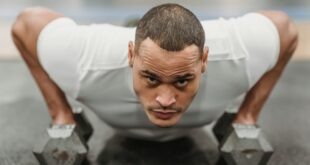The body’s oxygen levels can drop during exercise, which is a problem for people on oxygen. Using oxygen therapy can help prevent this from happening.
Studies have shown that nonhypoxemic COPD patients who undergo exercise training with supplemental oxygen achieve higher intensities and improve their exercise capacity more than those who train without oxygen.
Breathing Technique
The key to exercising while on oxygen therapy is using a breathing technique that helps make the process easier and reduces discomfort. One method of doing this is to practice diaphragmatic breathing. Diaphragmatic breathing, also called belly breathing, is a form of deep breathing that involves inflating the lower abdomen as you breathe in rather than just the chest. It’s a simple exercise to do, and it can significantly reduce the distress you feel when short of breath during workouts.
Hydrating properly is another way to help yourself when you’re exercising while on oxygen. This is important because dehydration makes it more difficult to clear your lungs of mucus, which can impede your breathing and cause coughing when you’re trying to work out. Many patients find drinking plenty of water, which can be done by drinking at least eight glasses of water a day, is very helpful.
It’s also important to keep your oxygen tank or portable concentrator close during exercise. This allows you to easily reach it when you need a new supply of oxygen or change the tubing that connects you to your device. This is especially true for exercises that involve a lot of movement, such as running or walking, since you’ll likely be moving around quite a bit, and it can be easy to trip over or run into the extension tubes that connect you to your equipment.
You can also try to choose more fluid and slower-paced exercises, such as yoga or tai chi, since these types of movements will allow you to move more easily without having to lug around your oxygen tank or concentrator. If you do this, make sure to fasten your tube down securely before you begin to prevent it from coming loose or tripping you up as you move. You can use a large safety pin (being careful not to pierce the tubing) or, preferably, a clip that you can hook onto your shirt or waistband. This is a much safer way to keep your tube from getting in the way and preventing you from doing your exercises.
Equipment
Oxygen therapy equipment can be bulky and difficult to maneuver, especially during exercise. This can affect your ability to work out, but with a little practice, you can learn to manage this equipment and keep moving. Below are a few tips to help you work out more easily on oxygen.
First, ensure you have a full supply of oxygen and are within easy reach. Depending on your needs, you may want to bring a spare battery or an extra cannula with you in case the first one runs out during your exercise session. It’s also a good idea to bring a water bottle and some snacks with you, as these can help keep your energy up during exercise.
Next, you’ll need to find a way to secure your long extension tubing that connects your nasal cannula to your oxygen source. Some people use a large safety pin (being careful not to pierce the tube), while others find that a tubing clip works better. It’s important that your tubing isn’t in the way of your movements because it can pull on your nose or mouth and cause irritation.
For some exercises, you can put your oxygen tubing in a bag or other container to hold it out of the way while exercising. This is particularly helpful for higher-intensity workouts like weight lifting or running. However, most people will prefer to keep their tank or portable concentrator nearby to get it back quickly if needed.
Take breaks regularly if you’re worried about getting too tired while working out on oxygen. Taking small breaks at regular intervals will allow you to replenish your blood oxygen levels and get ready for the next set of reps. It’s a good idea to start with shorter break times and then slowly work your way up to longer periods of time. Taking frequent breaks can help prevent overexertion, which is a common cause of exercise-related respiratory symptoms in people with chronic lung conditions.
Take Breaks
As you get used to exercising while using oxygen therapy, you may still feel breathless from time to time. That’s normal, so be sure to take breaks as needed, especially when you feel your breathing slowing down or getting short of breath. It’s also a good idea to take your time and not push yourself too hard during your workout.
You’ll likely find that slower-paced exercises, like walking or yoga, are easier to do on oxygen than more vigorous exercise routines. This is because you can use a wheeled cart or portable concentrator to help with movement, and you’re less likely to get tripped up by long extension tubing that connects your nasal cannula or mask to your oxygen source.
Oxygen therapy helps you exercise more easily because it stabilizes your blood oxygen levels, which is crucial during physical activity. If your blood oxygen levels drop during exercise, it can make it difficult to breathe, cause fatigue, and exacerbate any underlying heart or respiratory conditions.
Using oxygen during exercise may also reduce the impact of high blood pressure and heart rate on your body, so it’s important to keep these factors in mind when you’re working out. In addition, you should make a point to always take a few minutes after your workout for a cool-down period to allow your heart rate and blood pressure to return to normal.
A regular exercise routine is also a great way to improve your overall quality of life, and oxygen therapy can help you continue living a healthy lifestyle. If you’re unsure about how to work out on oxygen or if you’re having trouble with your equipment, we’ve put together a comprehensive guide of tips, practical techniques, and DIY fixes that can make it easier to exercise while on oxygen.
You can learn how to exercise while on oxygen and get the most out of your routine with a little practice. Just remember to take it slowly and consult your doctor before making any major changes to your workout. The more you exercise, the stronger your body will become, which will make it easier to manage daily activities and workouts even when you’re on oxygen.
Exercises
You can do plenty of exercises while on oxygen therapy, and it’s important to start slowly and gradually increase your intensity over time so you don’t push yourself too hard and cause any damage. Cardio workouts like jogging in place or using a stationary bike can be effective, as can resistance band workouts and free weight training. It’s also a good idea to include yoga in your routine, as it helps strengthen the muscles in your body while improving balance and flexibility.
When you’re exercising while on oxygen, it’s very easy to shift your focus and lose track of your breathing technique. It’s recommended that you practice exercising without any distractions so you can become accustomed to keeping your concentration focused solely on breathing correctly. Even if you exercise with music or TV on in the background, it’s still worth trying to work out without any distractions for a week or so to see how much of a difference your focus can make.
Another common issue when working out while on oxygen is the jostling of your mask or nasal cannula and extension tubing as you move around during a workout. You can prevent this from happening by fastening your tubing securely down, either with a large safety pin (being careful not to pierce the tube) or – more conveniently – with a clip that can be hooked to the back of your shirt. Some patients also find that placing the tubing inside a sweatshirt effectively keeps it out of the way as they work out.
If you’re new to exercising while on oxygen, it might take some time for you to get used to the equipment and how to use it correctly. Be patient, and don’t be afraid to ask for help from your doctor if you need it. They will be able to tell you if there are any special considerations you need to make and what kind of exercise is best for your health and fitness goals. They can also recommend a range of safe and effective exercise routines to suit your specific needs.
 HammBurg Be informed with latest news, reviews, entertainment, lifestyle tips, and much more.
HammBurg Be informed with latest news, reviews, entertainment, lifestyle tips, and much more.




